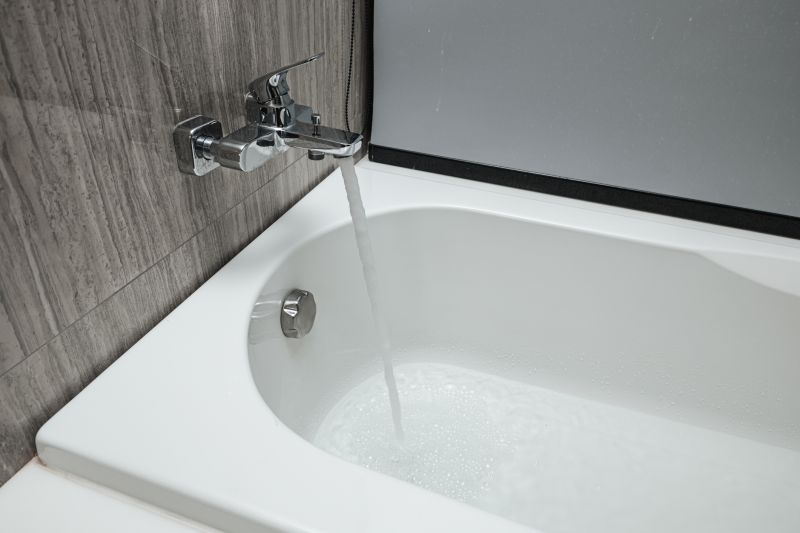Favorite Bathtub Refinishings Products For Easy DIY Renovations
Get the best tools and coatings that make bathtub refinishing simple and effective for any DIY enthusiast.
 Bathtub refinishing is a practical solution for revitalizing worn or outdated tubs, offering a fresh appearance without the need for complete replacement. The process typically involves cleaning the existing surface thoroughly, repairing any chips or cracks, and applying a specialized coating that adheres well to the original material. This coating can transform the look of a bathroom, making it appear cleaner and more modern. When considering products for bathtub refinishing, it is important to select materials that provide durability, smooth finish, and ease of application.
Bathtub refinishing is a practical solution for revitalizing worn or outdated tubs, offering a fresh appearance without the need for complete replacement. The process typically involves cleaning the existing surface thoroughly, repairing any chips or cracks, and applying a specialized coating that adheres well to the original material. This coating can transform the look of a bathroom, making it appear cleaner and more modern. When considering products for bathtub refinishing, it is important to select materials that provide durability, smooth finish, and ease of application.
Top Overall Option
Epoxy Refinishing Coating
An epoxy-based refinishing coating is widely regarded for its strong adhesion and durable finish. It provides a smooth, glossy surface that can resist moisture, stains, and daily wear. When applied properly, epoxy coatings can help restore the appearance of a worn or stained bathtub, offering a long-lasting solution that maintains its finish over time.
Types of Products For Bathtub Refinishings
Epoxy Coatings
Epoxy coatings are popular for their durability and strong adhesion, suitable for various bathtub materials.
Acrylic Enamel Paints
Acrylic enamel paints provide a smooth, glossy finish and are often used for DIY refinishing projects.
Urethane-Based Coatings
Urethane coatings offer excellent chemical and moisture resistance, ideal for high-use bathrooms.
Polyurethane Sealants
Polyurethane sealants help protect the refinished surface and enhance gloss and durability.
Refinishing Kits
Complete kits include primers, paints, and sealants designed specifically for bathtub restoration.
Repair Putty and Filler
Used to fix chips, cracks, and surface imperfections before applying the topcoat.
Bonding Agents
Enhance adhesion of the refinishing coating to the existing surface for a more durable finish.
High-Gloss Topcoats
Provide a shiny, mirror-like finish that enhances the appearance of the refinished tub.
Non-Slip Coatings
Applied to prevent slips and falls on refinished surfaces, especially in high-traffic bathrooms.
Anti-Mildew Additives
Help inhibit mold and mildew growth on the surface, maintaining cleanliness and appearance.
Fast-Drying Formulations
Designed for quick application and curing, reducing downtime during refinishing projects.
Low VOC Coatings
Emit fewer volatile organic compounds, making them safer for indoor use.
Textured Finishes
Provide a non-slip surface with a matte or textured appearance for safety and aesthetic purposes.
Specialty Primers
Improve adhesion on challenging surfaces like porcelain or fiberglass.
Color-Matched Topcoats
Allow customization of the bathtub’s color to match bathroom decor.
Popular Choices
Known for their durability and strong adhesion, epoxy coatings are frequently used in refinishing projects.
A common choice for DIY refinishing, offering a smooth, glossy finish.
Valued for their chemical resistance and long-lasting finish.
All-in-one solutions that include primers, paints, and sealants for convenience.
Essential for fixing surface imperfections before applying the topcoat.
Enhance adhesion and improve the longevity of the refinishing layer.
Popular for their shiny finish that enhances the bathroom’s aesthetic.
Increasingly used to improve safety on refinished surfaces.
Help maintain a clean appearance by preventing mold growth.
Preferred for quick turnaround projects.
Chosen for indoor applications requiring lower emissions.
Selected for safety and aesthetic preferences.
Improve adhesion on porcelain surfaces for better results.
Allow customization and seamless integration with bathroom decor.
Refinishing products vary widely, from epoxy-based coatings to acrylic and urethane formulations. Each type offers different benefits in terms of adhesion, resistance to moisture, and finish quality. Proper surface preparation and application techniques are essential to achieving a long-lasting result. Many homeowners and professionals opt for kits that include primers, paints, and sealants designed specifically for bathtub surfaces. Using high-quality products can help ensure a uniform, glossy finish that withstands daily use.
Choosing the right refinishing products also involves considering the existing material of the bathtub, whether it is porcelain, cast iron, acrylic, or fiberglass. Some coatings are better suited for certain surfaces, providing better adhesion and resistance. Additionally, the drying time and ease of cleanup are important factors that can influence the overall refinishing experience. While some products are designed for DIY use, others may require professional application to achieve optimal results. Regardless of the approach, selecting the appropriate products can significantly impact the durability and appearance of the refinished bathtub.
Overall, investing in the right bathtub refinishing products can help restore the bathroom’s aesthetic appeal and extend the life of the existing fixture. Proper selection, preparation, and application are key to achieving a smooth, resilient finish that can withstand the rigors of daily use. Whether you are refreshing an older tub or updating a bathroom for aesthetic reasons, the right products can make a noticeable difference in the final outcome.
Key Buying Considerations
- Compatibility with existing bathtub material such as porcelain, fiberglass, or cast iron.
- Type of coating (epoxy, acrylic, urethane) suited for your specific needs and skill level.
- Durability and resistance to moisture, stains, and daily wear.
- Ease of application, especially if DIY or professional application is preferred.
- Drying and curing times to minimize bathroom downtime.
- Finish appearance, including gloss level and texture options.
- Adhesion properties to prevent peeling or chipping over time.
- Compatibility with repair products like fillers and primers.
- Safety considerations such as VOC content and fumes during application.
- Cost and availability of complete kits versus individual components.
- Availability of color options or custom matching if desired.
- Surface preparation requirements to ensure optimal adhesion.
- Additional features like anti-slip or anti-mildew properties.
- User reviews and recommendations for specific products or brands.
- Manufacturer instructions and support for best results.
